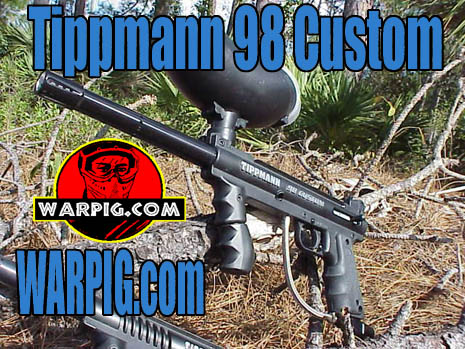  |
|
|
|
|
|
|
  |
|
|
|
|
|
|

What
do you think?
|

Tippmann Model 98 Custom with Response Trigger by Bill Mills December 2000 The Tippmann Model 98 has earned a solid reputation. By combining the durability and reliability of their previous designs with a light trigger pull, and a design that reduces manufacturing costs, Tippmann Pneumatics delivered a winner in the Model 98. So why a design update? While the Model 98 has been successful in its original design, many M98 owners have chosen to take their paintguns to airsmiths, or do work or instal parts themselves to tweak their paintgun to their own taste. While the new 98 Custom does not add these custom features to the stock design, it is better prepared to accept upgrades down the road.
Moving to the top of the receiver, there is a new ridge running down either side. The M98 sight rail is a Weaver style, while many sights for paintball and airguns are built to mount on a 3/8" rail. The 98 Custom features a dual rail, which can accept 3/8" mount sights and most Weaver mount sights (some Weaver mount sights have a tight clearance which prohibits mounting on a dual standard rail).
The back edge of the 98 Custom trigger features a flat edged protrusion, that is used by the Response Trigger, if installed.
Mounted below the grip is the bottom line ASA adapter - another area of change in the 98 Custom. Rather than feeding gas out the right hand side and into an elbow to a hose, the new adapter is threaded in its front. This centered placement gets rid of the edges and corners of the elbow sticking out on the right hand side.
The Response Trigger One of the first upgrades designed just for the 98 Custom is the Response trigger. Much like the Reactive Trigger feature of an Automag RT, the Response Trigger "kicks back" with more force once the paintgun fires. The result is that the user is able to fire more rapidly, because the added trigger return force means less time is spent releasing the trigger for the next shot.
Just how responsive/reactive should a trigger be? Within the NPPL, and many other leagues, reactive triggers are allowed, so long as they are not too reactive. The exact lines of what is and is not allowed are somewhat fuzzy, but according to NPPL Rules Committee Chairman, reactive triggers become unacceptable when they are "runaway triggers." As a trigger is tuned to become more reactive, there comes a point where the trigger return weight is so much greater than the trigger pull weight that a light pressure fires a string of shots without the user intentionally making distinct pulling motions, even through a complete trigger cycle occurs for each shot. Rules aside, a real problem with runaway triggers is the possibility of firing faster than current loader technology can deliver paintballs to the paintgun.
Performance - This is where it gets fun... "It rips!" is a pretty good summary. In testing the 98 Custom with Response Trigger for review, it became apparent that if dialed wide open to a runaway trigger, it is possible to outpace a Revolution loader and chop paint. Setting the trigger to a good level of reactivity makes quick firing very practical. To see the difference the Reactive Trigger can make, a test set-up was used with a barrel plug equpped with an impact transducer wired to a computer waveform recorder. The result is a nice chart showing each time a burst of gas is fired into the barrel. Below are two charts, one a string fired "as fast as possible" with the Response valve closed. The second, is recorded with a runaway trigger cycling with the valve completely open. Click on the graphs for a more detailed view. Rapid Firing with Response
Trigger Off
Bursts fired with Response Trigger on 100% The data clearly shows the power of the Response Trigger. It is important to keep in mind that this data does not represent a perfect empirical test - is it is subject to variances in the person pulling the trigger. It is also important to note, that the testing denotes bursts of gas, and not loading/firing, or the ability of the valve to charge at high rates of fire without velocity drop-off (i.e. - it would be a misinterpretation to say "the test proves that Tippmann's shoot fine at 20 shots/second"). With the Response trigger fully active, the cyclic rate in a runaway trigger burst is roughly double what the test shooter could achieve without it. Light pulls on the trigger often resulted in 2 or three round bursts. Just a minute or so of dry firing while adjusting the Response Trigger valve is all that is needed to prevent a runaway trigger. When tuned to the shooter's taste, the 98 Custom enters a new realm of firepower, without feed problems. |
| Copyright © 1992-2019
Corinthian Media Services. WARPIG's webmasters can be reached through our feedback form. All articles and images are copyrighted and may not be redistributed without the written permission of their original creators and Corinthian Media Services. The WARPIG paintball page is a collection of information and pointers to sources from around the internet and other locations. As such, Corinthian Media Services makes no claims to the trustworthiness or reliability of said information. The information contained in, and referenced by WARPIG, should not be used as a substitute for safety information from trained professionals in the paintball industry. |